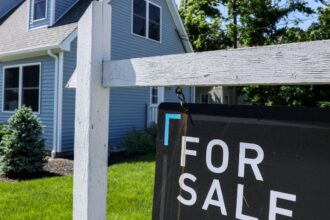My mother, 87, has minimal savings, and has $425,000 left on her mortgage.
Her monthly payment is $3,300 and the home is valued between $800,000 and $1.1 million. But her Social Security payment is only $3,000 a month.
I am supporting her right now. I have five siblings, but only one other is in a position to assist her financially. My mother wants to stay in her home until she dies. I was hoping to get about $250,000 to $300,000 in equity out of the home to provide for her until she passes away.
But the debt-to-income ratio rules out a home-equity loan, or the ability to refinance. A reverse mortgage with about $40,000 in fees would net her $80,000 to $100,000 in cash, with her mortgage, insurance and taxes amounting to $40,000 a year.
Should I sell the house to settle her debt when she passes? I am not expecting any kind of inheritance.
Can you think of a creative way I can get there?
Exploring My Options
‘The Big Move’ is a MarketWatch column looking at the ins and outs of real estate, from navigating the search for a new home to applying for a mortgage.
Do you have a question about buying or selling a home? Do you want to know where your next move should be? Email Aarthi Swaminathan at [email protected].
Dear Exploring,
Kudos to you for stepping up to the plate. There are six of you, but only you have taken on the big but very important responsibility of caring for your elderly mother.
A reverse mortgage seems like a good plan, given that you plan on selling the home after your 87-year-old mother passes, and since you are not expecting to inherit the home. It seems like the least expensive path to provide for her, and you can sell the house once she’s gone.
But you need to find out if the reverse mortgage will impact her Social Security income, if she is on specific needs-based programs such as supplemental security income.
“One workaround is simply spending your reverse mortgage proceeds in the same month you receive them,” according to American Advisors Group, a reverse-mortgage lender. Word of warning: “If the drawn funds are not spent, they could accumulate and exceed the allowable limit for SSI or Medicaid in your state.”
“Another is opening your reverse mortgage as a line of credit,” the company adds. “This strategy generally won’t impact SSI or Medicaid, because a reverse mortgage line of credit is not counted as a liquid asset or income until you actually use it. If you use the line, however, be sure to spend the funds in the same month they are received.”
Your mother would likely need a debt-to-income ratio of 43% or less, according to Bankrate. “The debt-to-income (DTI) ratio is a measure of your gross monthly income relative to your monthly debt payments, including your mortgage and home equity loan payments,” it adds. “Qualifying DTI ratios can vary from lender to lender, but, in general, the lower your DTI, the better.”
Home-equity investment
Another idea is to take on a home-equity investment. So with a HEI, unlike a HELOC, a company or a lender will buy a portion of your mother’s future home equity and she will get a lump sum cash payment in return, according to Tomo Mortgage. The company does not offer the product, but a spokesperson for the company thought it would make sense for this situation.
For example, if your mother has around $400,000 in equity accrued, she can extract that $400,000 in cash by giving a home-equity investment company a 25% share of the home’s future appreciation.
You’re basically setting up a way for her to share the equity she has in her home with a lender, for which she will be financially compensated. With a HEI, you don’t need to worry about a high debt-to-income ratio.
But bear in mind that this can come with risks, since this is a relatively new type of financial product. There may be terms, fees and costs that could surprise you, so don’t make any decision without the help of a real-estate or trust-and-estate attorney.
And when you sell the home, you will have to pay back the company the amount you took in cash and 25% — or an even bigger chunk — of the home’s appreciated value, the spokesperson for Tomo Mortgage added.
Talk to several lenders, and weigh the upsides and downsides of each option carefully. Some lenders may have other creative options for you, but always do your own legal and financial due diligence on any offers you receive.
By emailing your questions, you agree to having them published anonymously on MarketWatch. By submitting your story to Dow Jones & Company, the publisher of MarketWatch, you understand and agree that we may use your story, or versions of it, in all media and platforms, including via third parties.
Read the full article here










